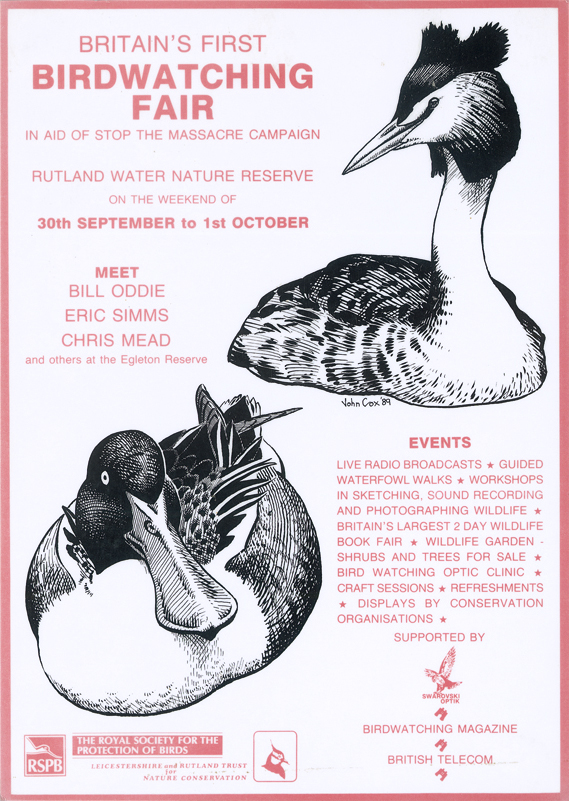
The first-ever Birdwatching Fair in 1989 attracted some big-name birders and was a village fête compared to the rock festival-sized affair it has become in recent years.
81 : British Birdwatching Fair poster
1989

The first-ever Birdwatching Fair in 1989 attracted some big-name birders and was a village fête compared to the rock festival-sized affair it has become in recent years.
After a two-year gestation period during which it evolved from an event called The Wildfowl Bonanza, the British Birdwatching Fair – or more simply Birdfair – was finally born in 1989. This annual event takes place at the extensive Rutland Water Nature Reserve, Leicestershire, a drinking-water reservoir owned by Anglian Water that opened in 1976, after the former Empingham Reservoir was dammed and extensively reworked.
Co-founder of the event, Tim Appleton, said: “On a personal level, I had been at Rutland Water since 1975 and, though keen to stay on there, I needed new challenges. I went to a nearby game fair (there are several around the country) and it struck me that as the shooters and hunters had such an event, why not birders?” He contacted his friend Martin Davies at the RSPB, and held a meeting in the appropriately named Finch’s Arms to discuss how to convince those involved in the already burgeoning birding industry to take part. A big help was Bruce Hansen of binocular retailer In Focus, who contacted the major optics manufacturers, all of whom leapt at the idea. Clothing, travel and publishing companies followed suit.
Rutland seemed ideal, being almost dead centre of ‘populated’ Britain, with good rail and road access, and plenty of hotel space. This was to prove particularly important as the event grew, with every hotel for up to 50 miles now usually fully booked, often from the previous year.
Initially, the agricultural land surrounding the artificial but wildlife-rich wetland found use as a grassy forum for a small selection of stalls and marquees that in the first year attracted about 3,000 people, raising some £3,000 to help stop hunting in Malta. Attendance has consistently risen to more than 20,000 in recent years, with 11 marquees, two smaller lecture tents and numerous food and drink stands catering for entertainment and refreshment needs.
Taking place annually over three days in August, the full-time staff at Rutland are augmented by scores of volunteers from both the reserve itself and from the RSPB and wildlife trusts – the staff have truly grown with the fair, and the organisers are at pains to point out the essential help of the scores of volunteers, many of whom have returned year after year, only for non-material rewards.
The contributions to conservation have been significant, too – not just financially, but in promoting little known but crucial global, and often cross-border, projects and objectives. Successes include funding the initial campaign against long-line fishing in 2000, helping to prevent the unsustainable number of albatross deaths caused by this poorly targeted tuna-fishing method; David Attenborough’s keynote 2008 speech in Peterborough on birds-of-paradise, which attracted more than 1,400 people; and the discovery on a Birdfair-funded expedition to Burma of more than 5,000 pairs of Gurney’s Pitta, a species previously believed to number just dozens.
The event has always avoided UK-centred projects, regarding them as already well-catered for, and instead consistently aimed for a local to national to international flow of funds and publicity, in some ways pre-empting the current vogue for the protection of birds’ flyways and summer and winter territories together – a kind of holistic approach to conservation. Birdfair’s conservation themes have evolved over the decades from saving particular forests and deltas in developing countries like Vietnam and Ecuador to continental-scale campaigns like the most recent support for BirdLife International’s Preventing Extinctions programme, most recently focusing on the migratory flyways of the Americas in the fair’s 25th year.
The event is also central in providing a commercial market for the entire birding industry – artists, writers, publishers, optics manufacturers, ecotravel companies and guides, and garden bird food specialists – enabling bird enthusiasts of all kinds to try out and purchase the latest innovations and products, and to socialise and network in what is also the world’s biggest ecotourism fair. It also has great importance in drawing attention to pressing conservation issues, and accordingly each fair has an over-arching theme every year, collectively raising a sum its founders estimate to be more than £3.3 million to date. This is aided by the large number of attendant celebrities freely giving their services, as well as the selfless volunteers.
The marquees attract a substantial number of international participants in addition to British birders, and the success of the Rutland event has seen it echoed in some form on every continent bar Antarctica. In fact, Tim Appleton says that he is perhaps proudest of the number of similar events that have sprung up around the world, like wind-blown seedlings. This has resulted in matched funding with many of the other fairs for projects in their countries, to the tune of more than £20 million and counting – perhaps the UK event’s greatest legacy of all.